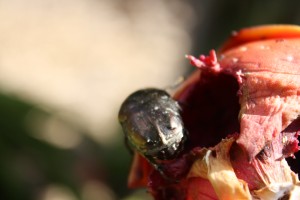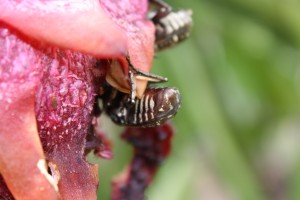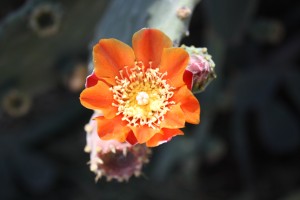
A dragon fruit with the dried flower still attached.
Photo: Hanul Seo/Kapiʻo
There are three varieties of dragon fruit in KapCC’s cactus and succulent garden. Some Tuesdays ago I saw that some of the fruits were in season, and decided to write about them.
After asking several people, I still wasn’t sure who the person in charge of the garden was, so I just Googled “kcc cactus garden” and ended up reading about Mr. Moriso Teraoka and the origin of our cactus and succulent garden. Read about him at the Hawaiʻi Memory Project here.
I was able to obtain two fruits after tracking him down and getting his permission. He also lent me a small booklet called “Beginner’s Guide to Grow Dragon Fruit in the Home Garden” by William Chow. Any following trivia about the dragon fruit has been taken from this booklet.
Sometimes, this rather expensive cactus fruit shows up in the markets. The red-skinned, white-fleshed variety requires little maintenance and is thus the most commonplace, while the yellow-skinned white-fleshed ones and the red-skinned, purple-fleshed ones are rarer because they need to be cross-pollinated. So far in my experience the white ones have been less sweet than the purple ones. Unfortunately, sometimes I can’t really tell which one is which.
If you know what the plants look like, you can spot many of them growing over walls, along certain hillsides, and in other people’s yards. There are even some small, awful-tasting ones growing right beside the Koko Head trail. In its native central America, the dragon fruit is called “pitaya.” It seems to do well here without much supervision.
You may have heard of or seen the flower called night blooming cereus. This is the flower of the dragon fruit. I wasn’t able to catch any flowers blooming this time, because I didn’t feel like busing home from campus in the middle of the night.
Back to the garden. Many of the fruits were overripe, and there were beetles gorging on their exposed flesh.
This is Protaetia orientalis, commonly known as the Oriental Flower Beetle.

A beetle emerges from a hole in the fruit.
Photo: Hanul Seo/Kapiʻo

More beetles hollowing out the fruit.
Photo: Hanul Seo/Kapiʻo
I touched a fruit, and what initially looked like seeds took flight and aggregated into a swarm of small dark bodies. Legions of flies were burrowing into the mush.

The flesh was pockmarked by flies.
Photo: Hanul Seo/Kapiʻo
Juice dripped out of the sun-blasted fruits like blood.

Not a crime scene.
Photo: Hanul Seo/Kapiʻo
Among the rocks near the base of the plant, I found moltings that probably belonged to beetle grubs. They were thin, crispy and fragile like the brown shell around a burnt popcorn kernel.

Something left this behind.
Photo: Hanul Seo/Kapiʻo
On the trellis, there were geckos basking in the sun.

Geckos are solar powered. Don’t quote me on this.
Photo: Hanul Seo/Kapiʻo
I tried not to gore myself on the spines of the plant as I took pictures.
This is a prickly pear cactus. It has very minute splinter-like hairs that come off in your skin if you’re clumsy enough to bump into it while trying to take pictures. Experienced harvesters use a blowtorch to burn off all the little hairs growing in small tufts on the fruit. Then they pluck off the fruit with tongs. All this while wearing gloves. Elsewhere when I’ve had prickly pears, they’ve often turned out to be bland, mealy, and full of stony little seeds. It’s a hit-or-miss kind of thing. I tried to get this one but gave up. Please enjoy these pictures while I nurse my wounds.

Don’t touch this. Really.
Photo: Hanul Seo/Kapiʻo

Just look.
Photo: Hanul Seo/Kapiʻo
The dragon fruits and the prickly pears are only two among many cacti growing in the garden, and all cactus fruits are edible. There are thus many more to write about. I hope to cover most of the useful or edible plants on campus eventually, since they’re often overlooked or taken for granted.
We have a very unique campus with many strange things living and growing in the gardens. I figure that if I publish these kinds of articles regularly, somebody will end up volunteering to work in the garden or find some interesting research opportunities among the flora and fauna. Read about the more recent developments in the cactus and succulent garden here at discovernikkei.org
I took a short hiatus from writing this article to work on the back-to-school issue being published on August 26 (the first day of school). After that, I went back to the garden early one morning hoping to return Mr. Teraoka’s dragon fruit booklet and tell him about our upcoming issue. I wasn’t able to catch him that time. Instead, I met Mr. Sam Camp, who has been volunteering in the garden since 2006. I asked him how one would go about volunteering, and he was generous enough to give me his contact info. So if you would like to help out, please contact Mr. Camp at samcamp@hawaii.rr.com. Or drop by and ask the men in the light blue shirts how you can assist them.
